HPV Vaccine
Editor-In-Chief: C. Michael Gibson, M.S., M.D. [1]; Associate Editor(s)-in-Chief: Alonso Alvarado, M.D. [2]
Disclaimer
WikiDoc MAKES NO GUARANTEE OF VALIDITY. WikiDoc is not a professional health care provider, nor is it a suitable replacement for a licensed healthcare provider. WikiDoc is intended to be an educational tool, not a tool for any form of healthcare delivery. The educational content on WikiDoc drug pages is based upon the FDA package insert, National Library of Medicine content and practice guidelines / consensus statements. WikiDoc does not promote the administration of any medication or device that is not consistent with its labeling. Please read our full disclaimer here.
Overview
HPV Vaccine is a Adrenergic receptor agonist that is FDA approved for the prophylaxis of HPV types 6, 11, 16 and 18 infections. Common adverse reactions include erythema at injection site, injection site pain, injection site pruritus, swelling at injection site, nausea, dizziness, headache, fever.
Adult Indications and Dosage
FDA-Labeled Indications and Dosage (Adult)
Dosage
GARDASIL should be administered intramuscularly as a 0.5-mL dose at the following schedule: 0, 2 months, 6 months. [See Clinical Studies (14.8).]
Method of Administration
For intramuscular use only. Shake well before use. Thorough agitation immediately before administration is necessary to maintain suspension of the vaccine. Human papillomavirus quadrivalent vaccine should not be diluted or mixed with other vaccines. After thorough agitation, human papillomavirus quadrivalent vaccine is a white, cloudy liquid. Parenteral drug products should be inspected visually for particulate matter and discoloration prior to administration. Do not use the product if particulates are present or if it appears discolored. human papillomavirus quadrivalent vaccine should be administered intramuscularly in the deltoid region of the upper arm or in the higher anterolateral area of the thigh. Syncope has been reported following vaccination with human papillomavirus quadrivalent vaccine and may result in falling with injury; observation for 15 minutes after administration is recommended.
Single-Dose Vial Use
Withdraw the 0.5-mL dose of vaccine from the single-dose vial using a sterile needle and syringe and use promptly.
Prefilled Syringe Use
This package does not contain a needle. Shake well before use. Attach the needle by twisting in a clockwise direction until the needle fits securely on the syringe. Administer the entire dose as per standard protocol.
Off-Label Use and Dosage (Adult)
Guideline-Supported Use
There is limited information regarding Off-Label Guideline-Supported Use of HPV Vaccine in adult patients.
Non–Guideline-Supported Use
Prophylaxis of Adenocarcinoma in situ of cervix, due to Nonvaccine HPV types
- Dosing Information
Prophylaxis Cervical intraepithelial neoplasia, Grade 1, 2, and 3 due to Nonvaccine Human Papillomavirus Types
- Dosing Information
Pediatric Indications and Dosage
FDA-Labeled Indications and Dosage (Pediatric)
There is limited information regarding HPV Vaccine FDA-Labeled Indications and Dosage (Pediatric) in the drug label.
Off-Label Use and Dosage (Pediatric)
Guideline-Supported Use
There is limited information regarding Off-Label Guideline-Supported Use of HPV Vaccine in pediatric patients.
Non–Guideline-Supported Use
There is limited information regarding Off-Label Non–Guideline-Supported Use of HPV Vaccine in pediatric patients.
Contraindications
Hypersensitivity, including severe allergic reactions to yeast (a vaccine component), or after a previous dose of GARDASIL.
Warnings
Syncope
Because vaccinees may develop syncope, sometimes resulting in falling with injury, observation for 15 minutes after administration is recommended. Syncope, sometimes associated with tonic-clonic movements and other seizure-like activity, has been reported following vaccination with human papillomavirus quadrivalent vaccine. When syncope is associated with tonic-clonic movements, the activity is usually transient and typically responds to restoring cerebral perfusion by maintaining a supine or Trendelenburg position.
Managing Allergic Reactions
Appropriate medical treatment and supervision must be readily available in case of anaphylactic reactions following the administration of human papillomavirus quadrivalent vaccine.
Adverse Reactions
Clinical Trials Experience
Overall Summary of Adverse Reactions
Headache, fever, nausea, and dizziness; and local injection site reactions (pain, swelling, erythema, pruritus, and bruising) occurred after administration with human papillomavirus quadrivalent vaccine.
Syncope, sometimes associated with tonic-clonic movements and other seizure-like activity, has been reported following vaccination with human papillomavirus quadrivalent vaccine and may result in falling with injury; observation for 15 minutes after administration is recommended.
Anaphylaxis has been reported following vaccination with human papillomavirus quadrivalent vaccine.
Clinical Trials Experience
Because clinical trials are conducted under widely varying conditions, adverse reaction rates observed in the clinical trials of a vaccine cannot be directly compared to rates in the clinical trials of another vaccine and may not reflect the rates observed in practice.
Studies in Girls and Women (9 Through 45 Years of Age) and Boys and Men (9 Through 26 Years of Age)
In 7 clinical trials (5 Amorphous Aluminum Hydroxyphosphate Sulfate [AAHS]-controlled, 1 saline placebo-controlled, and 1 uncontrolled), 18,083 individuals were administered human papillomavirus quadrivalent vaccine or AAHS control or saline placebo on the day of enrollment, and approximately 2 and 6 months thereafter, and safety was evaluated using vaccination report cards (VRC)-aided surveillance for 14 days after each injection of human papillomavirus quadrivalent vaccine or AAHS control or saline placebo in these individuals. The individuals who were monitored using VRC-aided surveillance included 10,088 individuals 9 through 45 years of age at enrollment who received human papillomavirus quadrivalent vaccine and 7,995 individuals who received AAHS control or saline placebo. Few individuals (0.2%) discontinued due to adverse reactions. The race distribution of the 9- through 26-year-old girls and women in the safety population was as follows: 62.3% White; 17.6% Hispanic (Black and White); 6.8% Asian; 6.7% Other; 6.4% Black; and 0.3% American Indian. The race distribution of the 24- through 45-year-old women in the safety population of Study 6 was as follows: 20.6% White; 43.2% Hispanic (Black and White); 0.2% Other; 4.8% Black; 31.2% Asian; and 0.1% American Indian. The race distribution of the 9- through 26-year-old boys and men in the safety population was as follows: 42.0% White; 19.7% Hispanic (Black and White); 11.0% Asian; 11.2% Other; 15.9% Black; and 0.1% American Indian.
Common Injection-Site Adverse Reactions in Girls and Women 9 Through 26 Years of Age
The injection site adverse reactions that were observed among recipients of human papillomavirus quadrivalent vaccine at a frequency of at least 1.0% and also at a greater frequency than that observed among AAHS control or saline placebo recipients are shown in Table 1.

Common Injection-Site Adverse Reactions in Boys and Men 9 Through 26 Years of Age
The injection site adverse reactions that were observed among recipients of human papillomavirus quadrivalent vaccine at a frequency of at least 1.0% and also at a greater frequency than that observed among AAHS control or saline placebo recipients are shown in Table 2.

Evaluation of Injection-Site Adverse Reactions by Dose in Girls and Women 9 Through 26 Years of Age
An analysis of injection-site adverse reactions in girls and women by dose is shown in Table 3. Of those girls and women who reported an injection-site reaction, 94.3% judged their injection-site adverse reaction to be mild or moderate in intensity.

Evaluation of Injection-Site Adverse Reactions by Dose in Boys and Men 9 Through 26 Years of Age
An analysis of injection-site adverse reactions in boys and men by dose is shown in Table 4. Of those boys and men who reported an injection-site reaction, 96.4% judged their injection-site adverse reaction to be mild or moderate in intensity.

Common Systemic Adverse Reactions in Girls and Women 9 Through 26 Years of Age
Headache was the most commonly reported systemic adverse reaction in both treatment groups (human papillomavirus quadrivalent vaccine = 28.2% and AAHS control or saline placebo = 28.4%). Fever was the next most commonly reported systemic adverse reaction in both treatment groups (human papillomavirus quadrivalent vaccine = 13.0% and AAHS control or saline placebo = 11.2%).
Adverse reactions that were observed among recipients of human papillomavirus quadrivalent vaccine, at a frequency of greater than or equal to 1.0% where the incidence in the human papillomavirus quadrivalent vaccine group was greater than or equal to the incidence in the AAHS control or saline placebo group, are shown in Table 5.
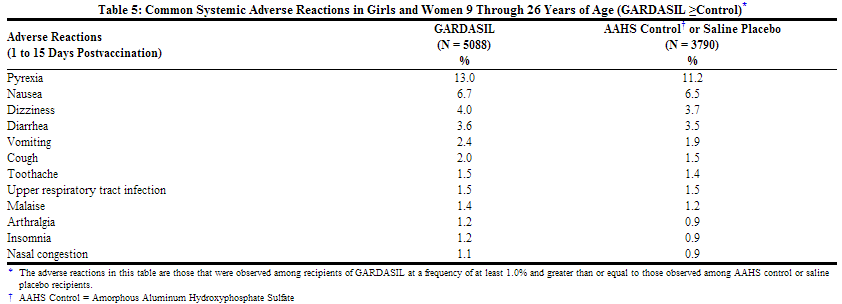
Common Systemic Adverse Reactions in Boys and Men 9 Through 26 Years of Age
Headache was the most commonly reported systemic adverse reaction in both treatment groups (human papillomavirus quadrivalent vaccine = 12.3% and AAHS control or saline placebo = 11.2%). Fever was the next most commonly reported systemic adverse reaction in both treatment groups (human papillomavirus quadrivalent vaccine = 8.3% and AAHS control or saline placebo = 6.5%).
Adverse reactions that were observed among recipients of human papillomavirus quadrivalent vaccine, at a frequency of greater than or equal to 1.0% where the incidence in the group that received human papillomavirus quadrivalent vaccine was greater than or equal to the incidence in the AAHS control or saline placebo group, are shown in Table 6.
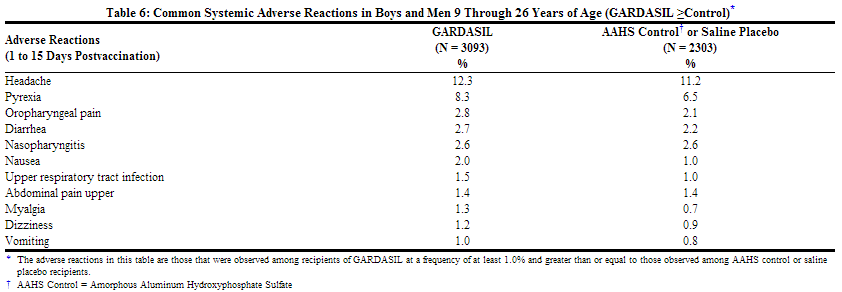
Evaluation of Fever by Dose in Girls and Women 9 Through 26 Years of Age
An analysis of fever in girls and women by dose is shown in Table 7.

Evaluation of Fever by Dose in Boys and Men 9 Through 26 Years of Age
An analysis of fever in boys and men by dose is shown in Table 8.

Serious Adverse Reactions in the Entire Study Population
Across the clinical studies, 258 individuals (human papillomavirus quadrivalent vaccine N = 128 or 0.8%; placebo N = 130 or 1.0%) out of 29,323 (human papillomavirus quadrivalent vaccine N = 15,706; AAHS control N = 13,023; or saline placebo N = 594) individuals (9- through 45-year-old girls and women; and 9- through 26-year-old boys and men) reported a serious systemic adverse reaction. Of the entire study population (29,323 individuals), 0.04% of the reported serious systemic adverse reactions were judged to be vaccine related by the study investigator. The most frequently (frequency of 4 cases or greater with either human papillomavirus quadrivalent vaccine, AAHS control, saline placebo, or the total of all three) reported serious systemic adverse reactions, regardless of causality, were: Headache [0.02% human papillomavirus quadrivalent vaccine (3 cases) vs. 0.02% AAHS control (2 cases)], Gastroenteritis [0.02% human papillomavirus quadrivalent vaccine (3 cases) vs. 0.02% AAHS control (2 cases)], Appendicitis [0.03% human papillomavirus quadrivalent vaccine (5 cases) vs. 0.01% AAHS control (1 case)], Pelvic inflammatory disease [0.02% human papillomavirus quadrivalent vaccine (3 cases) vs. 0.03% AAHS control (4 cases)], Urinary tract infection [0.01% human papillomavirus quadrivalent vaccine (2 cases) vs. 0.02% AAHS control (2 cases)], Pneumonia [0.01% human papillomavirus quadrivalent vaccine (2 cases) vs. 0.02% AAHS control (2 cases)], Pyelonephritis [0.01% human papillomavirus quadrivalent vaccine (2 cases) vs. 0.02% AAHS control (3 cases)], Pulmonary embolism [0.01% human papillomavirus quadrivalent vaccine (2 cases) vs. 0.02% AAHS control (2 cases)]. One case (0.006% human papillomavirus quadrivalent vaccine; 0.0% AAHS control or saline placebo) of bronchospasm; and 2 cases (0.01% human papillomavirus quadrivalent vaccine; 0.0% AAHS control or saline placebo) of asthma were reported as serious systemic adverse reactions that occurred following any vaccination visit. In addition, there was 1 individual in the clinical trials, in the group that received human papillomavirus quadrivalent vaccine, who reported two injection-site serious adverse reactions (injection-site pain and injection-site joint movement impairment).
Deaths in the Entire Study Population
Across the clinical studies, 40 deaths (human papillomavirus quadrivalent vaccine N = 21 or 0.1%; placebo N = 19 or 0.1%) were reported in 29,323 (human papillomavirus quadrivalent vaccine N = 15,706; AAHS control N = 13,023, saline placebo N = 594) individuals (9- through 45-year-old girls and women; and 9- through 26-year-old boys and men). The events reported were consistent with events expected in healthy adolescent and adult populations. The most common cause of death was motor vehicle accident (5 individuals who received human papillomavirus quadrivalent vaccine and 4 individuals who received AAHS control), followed by drug overdose/suicide (2 individuals who received human papillomavirus quadrivalent vaccine and 6 individuals who received AAHS control), gunshot wound (1 individual who received human papillomavirus quadrivalent vaccine and 3 individuals who received AAHS control), and pulmonary embolus/deep vein thrombosis (1 individual who received human papillomavirus quadrivalent vaccine and 1 individual who received AAHS control). In addition, there were 2 cases of sepsis, 1 case of pancreatic cancer, 1 case of arrhythmia, 1 case of pulmonary tuberculosis, 1 case of hyperthyroidism, 1 case of post-operative pulmonary embolism and acute renal failure, 1 case of traumatic brain injury/cardiac arrest, 1 case of systemic lupus erythematosus, 1 case of cerebrovascular accident, 1 case of breast cancer, and 1 case of nasopharyngeal cancer in the group that received human papillomavirus quadrivalent vaccine; 1 case of asphyxia, 1 case of acute lymphocytic leukemia, 1 case of chemical poisoning, and 1 case of myocardial ischemia in the AAHS control group; and 1 case of medulloblastoma in the saline placebo group.
Systemic Autoimmune Disorders in Girls and Women 9 Through 26 Years of Age
In the clinical studies, 9- through 26-year-old girls and women were evaluated for new medical conditions that occurred over the course of follow-up. New medical conditions potentially indicative of a systemic autoimmune disorder seen in the group that received human papillomavirus quadrivalent vaccine or AAHS control or saline placebo are shown in Table 9. This population includes all girls and women who received at least one dose of human papillomavirus quadrivalent vaccine or AAHS control or saline placebo, and had safety data available.
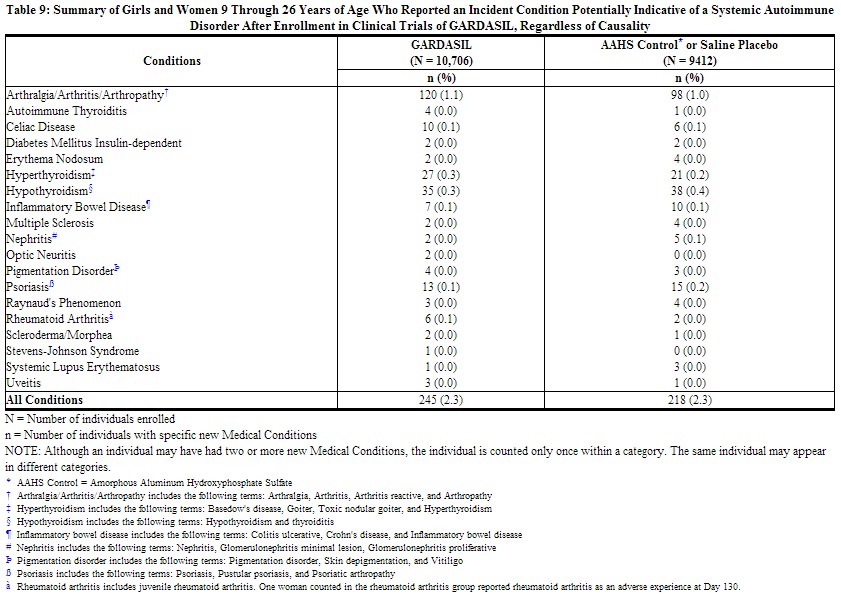
Systemic Autoimmune Disorders in Boys and Men 9 Through 26 Years of Age
In the clinical studies, 9- through 26-year-old boys and men were evaluated for new medical conditions that occurred over the course of follow-up. New medical conditions potentially indicative of a systemic autoimmune disorder seen in the group that received human papillomavirus quadrivalent vaccine or AAHS control or saline placebo are shown in Table 10. This population includes all boys and men who received at least one dose of human papillomavirus quadrivalent vaccine or AAHS control or saline placebo, and had safety data available.
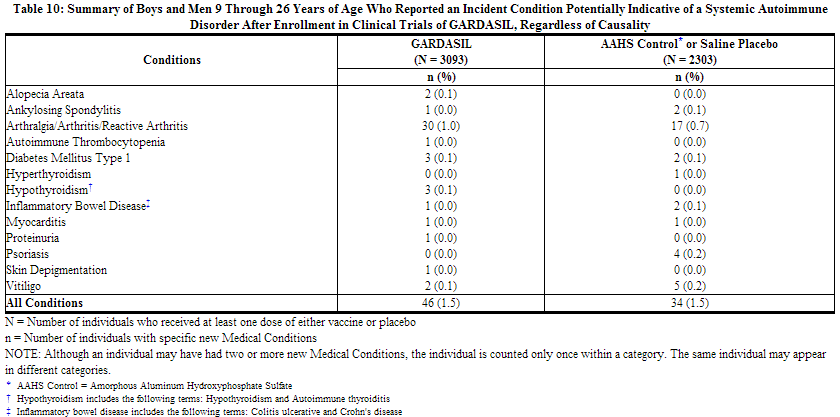
Safety in Concomitant Use with RECOMBIVAX HB® [hepatitis B vaccine (recombinant)] in Girls and Women 16 Through 23 Years of Age
The safety of human papillomavirus quadrivalent vaccine when administered concomitantly with hepatitis B vaccine (recombinant) was evaluated in an AAHS-controlled study of 1871 girls and women with a mean age of 20.4 years. The race distribution of the study individuals was as follows: 61.6% White; 23.8% Other; 11.9% Black; 1.6% Hispanic (Black and White); 0.8% Asian; and 0.3% American Indian. The rates of systemic and injection-site adverse reactions were similar among girls and women who received concomitant vaccination as compared with those who received human papillomavirus quadrivalent vaccine or hepatitis B vaccine (recombinant).
Safety in Concomitant Use with Menactra [Meningococcal (Groups A, C, Y and W-135) Polysaccharide Diphtheria Toxoid Conjugate Vaccine] and Adacel [Tetanus Toxoid, Reduced Diphtheria Toxoid and Acellular Pertussis Vaccine Adsorbed (Tdap)]
The safety of human papillomavirus quadrivalent vaccine when administered concomitantly with Menactra [Meningococcal (Groups A, C, Y and W-135) Polysaccharide Diphtheria Toxoid Conjugate Vaccine] and Adacel [Tetanus Toxoid, Reduced Diphtheria Toxoid and Acellular Pertussis Vaccine Adsorbed (Tdap)] was evaluated in a randomized study of 1040 boys and girls with a mean age of 12.6 years. The race distribution of the study subjects was as follows: 77.7% White; 1.4% Multi-racial; 12.3% Black; 6.8% Hispanic (Black and White); 1.2% Asian; 0.4% American Indian, and 0.2% Indian.
There was an increase in injection-site swelling reported at the injection site for human papillomavirus quadrivalent vaccine (concomitant = 10.9%, non-concomitant = 6.9%) when human papillomavirus quadrivalent vaccine was administered concomitantly with Menactra and Adacel as compared to non-concomitant (separated by 1 month) vaccination. The majority of injection-site swelling adverse experiences were reported as being mild to moderate in intensity.
Safety in Women 27 Through 45 Years of Age
The adverse reaction profile in women 27 through 45 years of age was comparable to the profile seen in girls and women 9 through 26 years of age.
Postmarketing Experience
The following adverse events have been spontaneously reported during post-approval use of human papillomavirus quadrivalent vaccine. Because these events were reported voluntarily from a population of uncertain size, it is not possible to reliably estimate their frequency or to establish a causal relationship to vaccine exposure.
- Blood and lymphatic system disorders: Autoimmune hemolytic anemia, idiopathic thrombocytopenic purpura, lymphadenopathy.
- Respiratory, thoracic and mediastinal disorders: Pulmonary embolism.
- Gastrointestinal disorders: Nausea, pancreatitis, vomiting.
- General disorders and administration site conditions: Asthenia, chills, death, fatigue, malaise.
- Immune system disorders: Autoimmune diseases, hypersensitivity reactions including anaphylaxis/anaphylactoid reactions, bronchospasm, and urticaria.
- Musculoskeletal and connective tissue disorders: Arthralgia, myalgia.
- Nervous system disorders: Acute disseminated encephalomyelitis, dizziness, Guillain-Barré syndrome, headache, motor neuron disease, paralysis, seizures, syncope (including syncope associated with tonic-clonic movements and other seizure-like activity) sometimes resulting in falling with injury, transverse myelitis.
- Infections and infestations: cellulitis.
- Vascular disorders: Deep venous thrombosis.
Drug Interactions
Use with RECOMBIVAX HB
Results from clinical studies indicate that human papillomavirus quadrivalent vaccine may be administered concomitantly (at a separate injection site) with hepatitis B vaccine (recombinant).
Use with Menactra and Adacel
Results from clinical studies indicate that human papillomavirus quadrivalent vaccine may be administered concomitantly (at a separate injection site) with Menactra [Meningococcal (Groups A, C, Y and W-135) Polysaccharide Diphtheria Toxoid Conjugate Vaccine] and Adacel [Tetanus Toxoid, Reduced Diphtheria Toxoid and Acellular Pertussis Vaccine Adsorbed (Tdap)].
Use with Hormonal Contraceptives
In clinical studies of 16- through 26-year-old women, 13,912 (human papillomavirus quadrivalent vaccine N = 6952; AAHS control or saline placebo N = 6960) who had post-Month 7 follow-up used hormonal contraceptives for a total of 33,859 person-years (65.8% of the total follow-up time in the studies).
In one clinical study of 24- through 45-year-old women, 1357 (human papillomavirus quadrivalent vaccine N = 690; AAHS control N = 667) who had post-Month 7 follow-up used hormonal contraceptives for a total of 3400 person-years (31.5% of the total follow-up time in the study). Use of hormonal contraceptives or lack of use of hormonal contraceptives among study participants did not impair the immune response in the per protocol immunogenicity (PPI) population.
Use with Systemic Immunosuppressive Medications
Immunosuppressive therapies, including irradiation, antimetabolites, alkylating agents, cytotoxic drugs, and corticosteroids (used in greater than physiologic doses), may reduce the immune responses to vaccines
Use in Specific Populations
Pregnancy
Pregnancy Category (FDA): B Reproduction studies have been performed in female rats at doses equivalent to the recommended human dose and have revealed no evidence of impaired female fertility or harm to the fetus due to human papillomavirus quadrivalent vaccine. There are, however, no adequate and well-controlled studies in pregnant women. Because animal reproduction studies are not always predictive of human responses, human papillomavirus quadrivalent vaccine should be used during pregnancy only if clearly needed.
An evaluation of the effect of human papillomavirus quadrivalent vaccine on embryo-fetal, pre- and postweaning development was conducted using rats. One group of rats was administered human papillomavirus quadrivalent vaccine twice prior to gestation, during the period of organogenesis (gestation Day 6) and on lactation Day 7. A second group of pregnant rats was administered human papillomavirus quadrivalent vaccine during the period of organogenesis (gestation Day 6) and on lactation Day 7 only. Human papillomavirus quadrivalent vaccine was administered at 0.5 mL/rat/occasion (120 mcg total protein which is equivalent to the recommended human dose) by intramuscular injection. No adverse effects on mating, fertility, pregnancy, parturition, lactation, embryo-fetal or pre- and postweaning development were observed. There were no vaccine-related fetal malformations or other evidence of teratogenesis noted in this study. In addition, there were no treatment-related effects on developmental signs, behavior, reproductive performance, or fertility of the offspring.
Clinical Studies in Humans
In clinical studies, women underwent urine pregnancy testing prior to administration of each dose of human papillomavirus quadrivalent vaccine. Women who were found to be pregnant before completion of a 3-dose regimen of human papillomavirus quadrivalent vaccine were instructed to defer completion of their vaccination regimen until resolution of the pregnancy. Human papillomavirus quadrivalent vaccine is not indicated for women 27 years of age or older. However, safety data in women 16 through 45 years of age was collected, and 3819 women (human papillomavirus quadrivalent vaccine N = 1894 vs. AAHS control or saline placebo N = 1925) reported at least 1 pregnancy each.
The overall proportions of pregnancies that resulted in an adverse outcome, defined as the combined numbers of spontaneous abortion, late fetal death, and congenital anomaly cases out of the total number of pregnancy outcomes for which an outcome was known (and excluding elective terminations), were 22.6% (446/1973) in women who received human papillomavirus quadrivalent vaccine and 23.1% (460/1994) in women who received AAHS control or saline placebo.
Overall, 55 and 65 women in the group that received human papillomavirus quadrivalent vaccine or AAHS control or saline placebo, respectively (2.9% and 3.4% of all women who reported a pregnancy in the respective vaccination groups), experienced a serious adverse reaction during pregnancy. The most common events reported were conditions that can result in Caesarean section (e.g., failure of labor, malpresentation, cephalopelvic disproportion), premature onset of labor (e.g., threatened abortions, premature rupture of membranes), and pregnancy-related medical problems (e.g., pre-eclampsia, hyperemesis). The proportions of pregnant women who experienced such events were comparable between the groups receiving human papillomavirus quadrivalent vaccine and AAHS control or saline placebo.
There were 45 cases of congenital anomaly in pregnancies that occurred in women who received human papillomavirus quadrivalent vaccine and 34 cases of congenital anomaly in pregnancies that occurred in women who received AAHS control or saline placebo.
Further sub-analyses were conducted to evaluate pregnancies with estimated onset within 30 days or more than 30 days from administration of a dose of human papillomavirus quadrivalent vaccine or AAHS control or saline placebo. For pregnancies with estimated onset within 30 days of vaccination, 5 cases of congenital anomaly were observed in the group that received human papillomavirus quadrivalent vaccine compared to 1 case of congenital anomaly in the group that received AAHS control or saline placebo. The congenital anomalies seen in pregnancies with estimated onset within 30 days of vaccination included pyloric stenosis, congenital megacolon, congenital hydronephrosis, hip dysplasia, and club foot. Conversely, in pregnancies with onset more than 30 days following vaccination, 40 cases of congenital anomaly were observed in the group that received human papillomavirus quadrivalent vaccine compared with 33 cases of congenital anomaly in the group that received AAHS control or saline placebo.
Pregnancy Category (AUS):
There is no Australian Drug Evaluation Committee (ADEC) guidance on usage of HPV Vaccine in women who are pregnant.
Labor and Delivery
There is no FDA guidance on use of HPV Vaccine during labor and delivery.
Nursing Mothers
Women 16 Through 45 Years of Age
It is not known whether human papillomavirus quadrivalent vaccine is excreted in human milk. Because many drugs are excreted in human milk, caution should be exercised when human papillomavirus quadrivalent vaccine is administered to a nursing woman. Human papillomavirus quadrivalent vaccine or AAHS control were given to a total of 1133 women (vaccine N = 582, AAHS control N = 551) during the relevant Phase III clinical studies.
Overall, 27 and 13 infants of women who received human papillomavirus quadrivalent vaccine or AAHS control, respectively (representing 4.6% and 2.4% of the total number of women who were breast-feeding during the period in which they received human papillomavirus quadrivalent vaccine or AAHS control, respectively), experienced a serious adverse reaction.
In a post-hoc analysis of clinical studies, a higher number of breast-feeding infants (n = 7) whose mothers received human papillomavirus quadrivalent vaccine had acute respiratory illnesses within 30 days post vaccination of the mother as compared to infants (n = 2) whose mothers received AAHS control.
Pediatric Use
Safety and effectiveness have not been established in pediatric patients below 9 years of age.
Geriatic Use
The safety and effectiveness of human papillomavirus quadrivalent vaccine have not been evaluated in a geriatric population, defined as individuals aged 65 years and over.
Gender
There is no FDA guidance on the use of HPV Vaccine with respect to specific gender populations.
Race
There is no FDA guidance on the use of HPV Vaccine with respect to specific racial populations.
Renal Impairment
There is no FDA guidance on the use of HPV Vaccine in patients with renal impairment.
Hepatic Impairment
There is no FDA guidance on the use of HPV Vaccine in patients with hepatic impairment.
Females of Reproductive Potential and Males
There is no FDA guidance on the use of HPV Vaccine in women of reproductive potentials and males.
Immunocompromised Patients
The immunologic response to human papillomavirus quadrivalent vaccine may be diminished in immunocompromised individuals
Administration and Monitoring
Administration
Intramuscular
Monitoring
There is limited information regarding HPV Vaccine Monitoring in the drug label.
IV Compatibility
There is limited information regarding the compatibility of HPV Vaccine and IV administrations.
Overdosage
- There have been reports of administration of higher than recommended doses of human papillomavirus quadrivalent vaccine.
- In general, the adverse event profile reported with overdose was comparable to recommended single doses of human papillomavirus quadrivalent vaccine.
Pharmacology
HPV Vaccine
| |
| ? | |
| Identifiers | |
| CAS number | ? |
| ATC code | J07 |
| PubChem | ? |
| Chemical data | |
| Formula | ? |
| Mol. mass | ? |
| Pharmacokinetic data | |
| Bioavailability | ? |
| Metabolism | ? |
| Half life | ? |
| Excretion | ? |
| Therapeutic considerations | |
| Pregnancy cat. |
B(US) |
| Legal status |
[[Prescription drug|Template:Unicode-only]](US) |
| Routes | intradermal injection |
Mechanism of Action
HPV only infects human beings. Animal studies with analogous animal papillomaviruses suggest that the efficacy of L1 VLP vaccines may involve the development of humoral immune responses. Human beings develop a humoral immune response to the vaccine, although the exact mechanism of protection is unknown.
Structure
GARDASIL, Human Papillomavirus Quadrivalent (Types 6, 11, 16, and 18) Vaccine, Recombinant, is a non-infectious recombinant quadrivalent vaccine prepared from the purified virus-like particles (VLPs) of the major capsid (L1) protein of HPV Types 6, 11, 16, and 18. The L1 proteins are produced by separate fermentations in recombinant Saccharomyces cerevisiae and self-assembled into VLPs. The fermentation process involves growth of S. cerevisiae on chemically-defined fermentation media which include vitamins, amino acids, mineral salts, and carbohydrates. The VLPs are released from the yeast cells by cell disruption and purified by a series of chemical and physical methods. The purified VLPs are adsorbed on preformed aluminum-containing adjuvant (Amorphous Aluminum Hydroxyphosphate Sulfate). The quadrivalent HPV VLP vaccine is a sterile liquid suspension that is prepared by combining the adsorbed VLPs of each HPV type and additional amounts of the aluminum-containing adjuvant and the final purification buffer. human papillomavirus quadrivalent vaccine is a sterile suspension for intramuscular administration. Each 0.5-mL dose contains approximately 20 mcg of HPV 6 L1 protein, 40 mcg of HPV 11 L1 protein, 40 mcg of HPV 16 L1 protein, and 20 mcg of HPV 18 L1 protein. Each 0.5-mL dose of the vaccine contains approximately 225 mcg of aluminum (as Amorphous Aluminum Hydroxyphosphate Sulfate adjuvant), 9.56 mg of sodium chloride, 0.78 mg of L-histidine, 50 mcg of polysorbate 80, 35 mcg of sodium borate, <7 mcg yeast protein/dose, and water for injection. The product does not contain a preservative or antibiotics. After thorough agitation, human papillomavirus quadrivalent vaccine is a white, cloudy liquid.
Pharmacodynamics
There is limited information regarding HPV Vaccine Pharmacodynamics in the drug label.
Pharmacokinetics
There is limited information regarding HPV Vaccine Pharmacokinetics in the drug label.
Nonclinical Toxicology
Carcinogenesis, Mutagenesis, Impairment of Fertility
Human papillomavirus quadrivalent vaccine has not been evaluated for the potential to cause carcinogenicity or genotoxicity. Human papillomavirus quadrivalent vaccine administered to female rats at a dose of 120 mcg total protein, which is equivalent to the recommended human dose, had no effects on mating performance, fertility, or embryonic/fetal survival.
The effect of human papillomavirus quadrivalent vaccine on male fertility has been studied in male rats at an intramuscular dose of 0.5 mL/rat/occasion (120 mcg total protein which is equivalent to the recommended human dose). One group of male rats was administered human papillomavirus quadrivalent vaccine once, 3 days prior to cohabitation, and a second group of male rats was administered human papillomavirus quadrivalent vaccine three times, at 6 weeks, 3 weeks, and 3 days prior to cohabitation. There were no treatment-related effects on reproductive performance including fertility, sperm count, and sperm motility. There were no treatment-related gross or histomorphologic and weight changes on the testes.
Clinical Studies
CIN 2/3 and AIS are the immediate and necessary precursors of adenocarcinoma and squamous cell carcinoma of the cervix, respectively. Their detection and removal has been shown to prevent cancer; thus, they serve as surrogate markers for prevention of cervical cancer. In the clinical studies in girls and women aged 16 through 26 years, cases of CIN 2/3 and AIS were the efficacy endpoints to assess prevention of cervical cancer. In addition, cases of VIN 2/3 and VaIN 2/3 were the efficacy endpoints to assess prevention of HPV-related vulvar cancer and vaginal cancer, and observations of external genital lesions were the efficacy endpoints for the prevention of genital warts.
In clinical studies in boys and men aged 16 through 26 years, efficacy was evaluated using the following endpoints: external genital warts and penile/perineal/perianal intraepithelial neoplasia (PIN) grades 1/2/3 or penile/perineal/perianal cancer. In addition, cases of AIN grades 1/2/3 and anal cancer made up the composite efficacy endpoint used to assess prevention of HPV-related anal cancer. Anal HPV infection, AIN, and anal cancer were not endpoints in the studies conducted in women. The similarity of HPV-related anal disease in men and women supports bridging the indication of prevention of AIN and anal cancer to women.
Efficacy was assessed in 6 AAHS-controlled, double-blind, randomized Phase II and III clinical studies. The first Phase II study evaluated the HPV 16 component of human papillomavirus quadrivalent vaccine (Study 1, N = 2391 16- through 26-year-old girls and women) and the second evaluated all components of human papillomavirus quadrivalent vaccine (Study 2, N = 551 16- through 26-year-old girls and women). Two Phase III studies evaluated human papillomavirus quadrivalent vaccine in 5442 (Study 3) and 12,157 (Study 4) 16- through 26-year-old girls and women. A third Phase III study, Study 5, evaluated human papillomavirus quadrivalent vaccine in 4055 16- through 26-year-old boys and men, including a subset of 598 (human papillomavirus quadrivalent vaccine = 299; placebo = 299) men who self-identified as having sex with men (MSM population). A fourth Phase III study, Study 6, evaluated human papillomavirus quadrivalent vaccine in 3817 24- through 45-year-old women. Together, these six studies evaluated 28,413 individuals (20,541 girls and women 16 through 26 years of age at enrollment with a mean age of 20.0 years, 4055 boys and men 16 through 26 years of age at enrollment with a mean age of 20.5 years, and 3817 women 24 through 45 years of age at enrollment with a mean age of 34.3 years). The race distribution of the 16- through 26-year-old girls and women in the clinical trials was as follows: 70.4% White; 12.2% Hispanic (Black and White); 8.8% Other; 4.6% Black; 3.8% Asian; and 0.2% American Indian. The race distribution of the 16- through 26-year-old boys and men in the clinical trials was as follows: 35.2% White; 20.5% Hispanic (Black and White); 14.4% Other; 19.8% Black; 10.0% Asian; and 0.1% American Indian. The race distribution of the 24- through 45-year-old women in the clinical trials was as follows: 20.6% White; 43.2% Hispanic (Black and White); 0.2% Other; 4.8% Black; 31.2% Asian; and 0.1% American Indian.
The median duration of follow-up was 4.0, 3.0, 3.0, 3.0, 2.3, and 4.0 years for Study 1, Study 2, Study 3, Study 4, Study 5, and Study 6, respectively. Individuals received vaccine or AAHS control on the day of enrollment and 2 and 6 months thereafter. Efficacy was analyzed for each study individually and for all studies in girls and women combined according to a prospective clinical plan. Overall, 73% of 16- through 26-year-old girls and women, 67% of 24- through 45-year-old women, and 83% of 16- through 26-year-old boys and men were naïve (i.e., PCR [Polymerase Chain Reaction] negative and seronegative for all 4 vaccine HPV types) to all 4 vaccine HPV types at enrollment.
A total of 27% of 16- through 26-year-old girls and women, 33% of 24- through 45-year-old women, and 17% of 16- through 26-year-old boys and men had evidence of prior exposure to or ongoing infection with at least 1 of the 4 vaccine HPV types. Among these individuals, 74% of 16- through 26-year-old girls and women, 71% of 24- through 45-year-old women, and 78% of 16- through 26-year-old boys and men had evidence of prior exposure to or ongoing infection with only 1 of the 4 vaccine HPV types and were naïve (PCR negative and seronegative) to the remaining 3 types. In 24- through 45-year-old individuals, 0.4% had been exposed to all 4 vaccine HPV types.
In individuals who were naïve (PCR negative and seronegative) to all 4 vaccine HPV types, CIN, genital warts, VIN, VaIN, PIN, and persistent infection caused by any of the 4 vaccine HPV types were counted as endpoints. Among individuals who were positive (PCR positive and/or seropositive) for a vaccine HPV type at Day 1, endpoints related to that type were not included in the analyses of prophylactic efficacy. Endpoints related to the remaining types for which the individual was naïve (PCR negative and seronegative) were counted.
For example, in individuals who were HPV 18 positive (PCR positive and/or seropositive) at Day 1, lesions caused by HPV 18 were not counted in the prophylactic efficacy evaluations. Lesions caused by HPV 6, 11, and 16 were included in the prophylactic efficacy evaluations. The same approach was used for the other types.
Prophylactic Efficacy – HPV Types 6, 11, 16, and 18 in Girls and Women 16 Through 26 Years of Age
Human papillomavirus quadrivalent vaccine was administered without prescreening for presence of HPV infection and the efficacy trials allowed enrollment of girls and women regardless of baseline HPV status (i.e., PCR status or serostatus). Girls and women with current or prior HPV infection with an HPV type contained in the vaccine were not eligible for prophylactic efficacy evaluations for that type.
The primary analyses of efficacy with respect to HPV types 6, 11, 16, and 18 were conducted in the per-protocol efficacy (PPE) population, consisting of girls and women who received all 3 vaccinations within 1 year of enrollment, did not have major deviations from the study protocol, and were naïve (PCR negative in cervicovaginal specimens and seronegative) to the relevant HPV type(s) (Types 6, 11, 16, and 18) prior to dose 1 and through 1 month Postdose 3 (Month 7). Efficacy was measured starting after the Month 7 visit.
Human papillomavirus quadrivalent vaccine was efficacious in reducing the incidence of CIN (any grade including CIN 2/3); AIS; genital warts; VIN (any grade); and VaIN (any grade) related to vaccine HPV types 6, 11, 16, or 18 in those who were PCR negative and seronegative at baseline (Table 11).
In addition, girls and women who were already infected with 1 or more vaccine-related HPV types prior to vaccination were protected from precancerous cervical lesions and external genital lesions caused by the other vaccine HPV types.
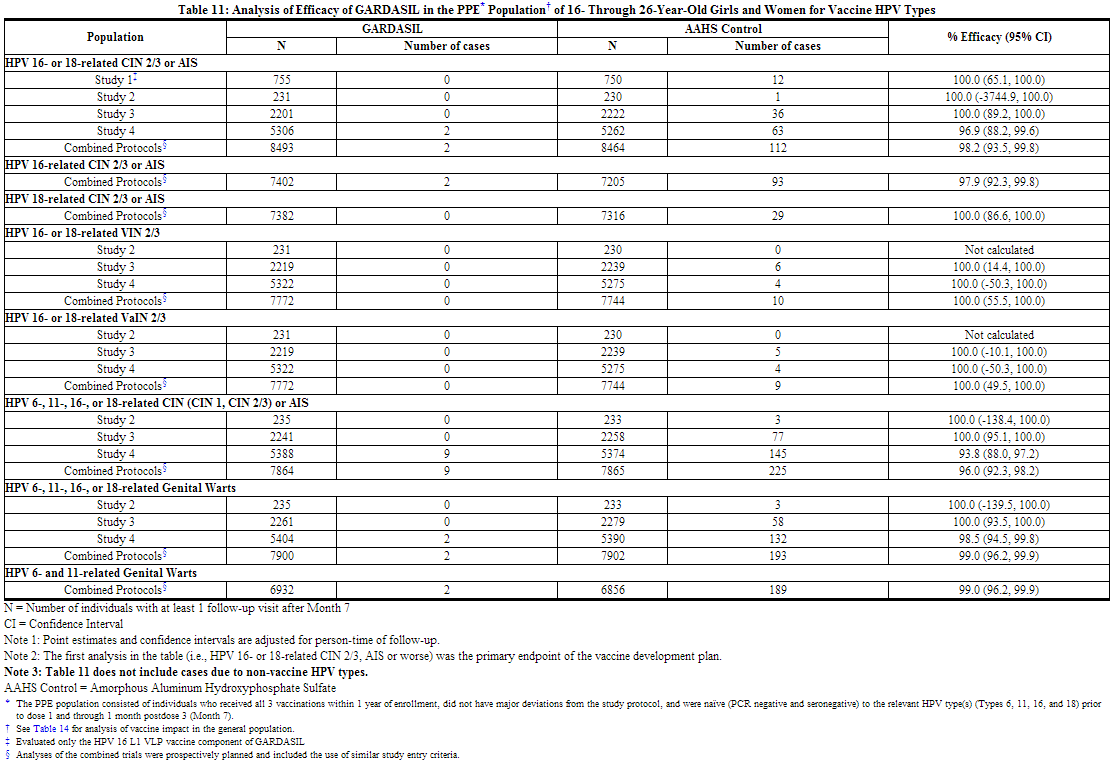
Prophylactic efficacy against overall cervical and genital disease related to HPV 6, 11, 16, and 18 in an extension phase of Study 2, that included data through Month 60, was noted to be 100% (95% CI: 12.3%, 100.0%) among girls and women in the per protocol population naïve to the relevant HPV types.
Human papillomavirus quadrivalent vaccine was efficacious against HPV disease caused by HPV types 6, 11, 16, and 18 in girls and women who were naïve for those specific HPV types at baseline.
Prophylactic Efficacy – HPV Types 6, 11, 16, and 18 in Boys and Men 16 Through 26 Years of Age
The primary analyses of efficacy were conducted in the per-protocol efficacy (PPE) population. This population consisted of boys and men who received all 3 vaccinations within 1 year of enrollment, did not have major deviations from the study protocol, and were naïve (PCR negative and seronegative) to the relevant HPV type(s) (Types 6, 11, 16, and 18) prior to dose 1 and through 1 month postdose 3 (Month 7). Efficacy was measured starting after the Month 7 visit.
Human papillomavirus quadrivalent vaccine was efficacious in reducing the incidence of genital warts related to vaccine HPV types 6 and 11 in those boys and men who were PCR negative and seronegative at baseline (Table 12). Efficacy against penile/perineal/perianal intraepithelial neoplasia (PIN) grades 1/2/3 or penile/perineal/perianal cancer was not demonstrated as the number of cases was too limited to reach statistical significance.

Prophylactic Efficacy – Anal Disease Caused by HPV Types 6, 11, 16, and 18 in Boys and Men 16 Through 26 Years of Age in the MSM Sub-study
A sub-study of Study 5 evaluated the efficacy of human papillomavirus quadrivalent vaccine against anal disease (anal intraepithelial neoplasia and anal cancer) in a population of 598 MSM. The primary analyses of efficacy were conducted in the per-protocol efficacy (PPE) population of Study 5.
Human papillomavirus quadrivalent vaccine was efficacious in reducing the incidence of anal intraepithelial neoplasia (AIN) grades 1 (both condyloma and non-acuminate), 2, and 3 related to vaccine HPV types 6, 11, 16, and 18 in those boys and men who were PCR negative and seronegative at baseline (Table 13).

Population Impact in Girls and Women 16 Through 26 Years of Age
Effectiveness of GARDASIL in Prevention of HPV Types 6-, 11-, 16-, or 18-Related Genital Disease in Girls and Women 16 Through 26 Years of Age, Regardless of Current or Prior Exposure to Vaccine HPV Types
The clinical trials included girls and women regardless of current or prior exposure to vaccine HPV types, and additional analyses were conducted to evaluate the impact of human papillomavirus quadrivalent vaccine with respect to HPV 6-, 11-, 16-, and 18-related cervical and genital disease in these girls and women. Here, analyses included events arising among girls and women regardless of baseline PCR status and serostatus, including HPV infections that were present at the start of vaccination as well as events that arose from infections that were acquired after the start of vaccination.
The impact of human papillomavirus quadrivalent vaccine in girls and women regardless of current or prior exposure to a vaccine HPV type is shown in Table 14. Impact was measured starting 1 month Postdose 1. Prophylactic efficacy denotes the vaccine's efficacy in girls and women who are naïve (PCR negative and seronegative) to the relevant HPV types at Day 1. Vaccine impact in girls and women who were positive for vaccine HPV infection, as well as vaccine impact among girls and women regardless of baseline vaccine HPV PCR status and serostatus are also presented. The majority of CIN and genital warts, VIN, and VaIN related to a vaccine HPV type detected in the group that received human papillomavirus quadrivalent vaccine occurred as a consequence of HPV infection with the relevant HPV type that was already present at Day 1.
There was no clear evidence of protection from disease caused by HPV types for which girls and women were PCR positive regardless of serostatus at baseline.
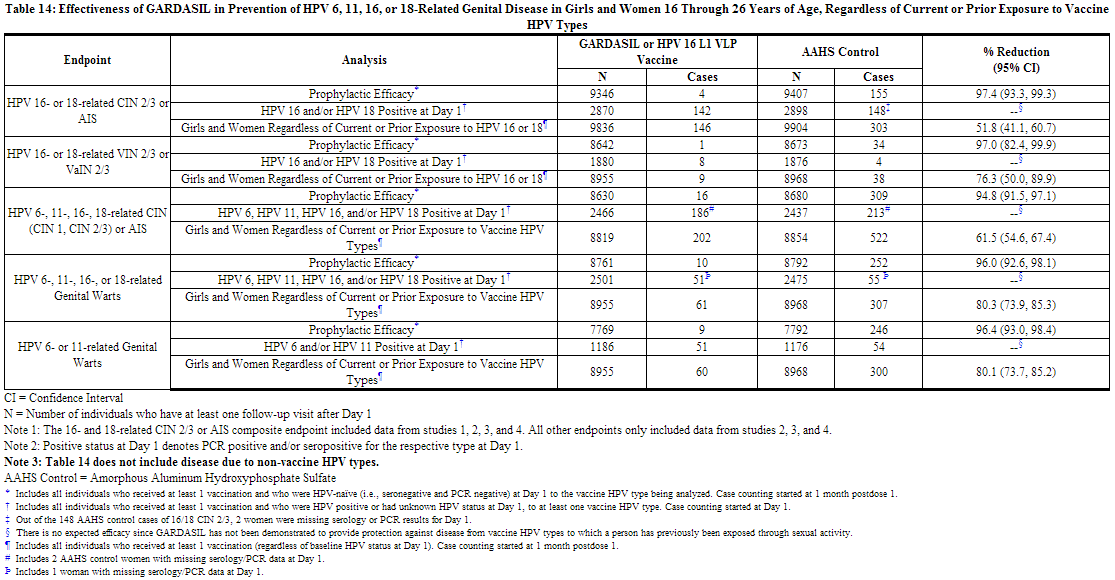
Effectiveness of Human Papillomavirus Quadrivalent Vaccine in Prevention of Any HPV Type Related Genital Disease in Girls and Women 16 Through 26 Years of Age, Regardless of Current or Prior Infection with Vaccine or Non-Vaccine HPV Types
The impact of human papillomavirus quadrivalent vaccine against the overall burden of dysplastic or papillomatous cervical, vulvar, and vaginal disease regardless of HPV detection, results from a combination of prophylactic efficacy against vaccine HPV types, disease contribution from vaccine HPV types present at time of vaccination, the disease contribution from HPV types not contained in the vaccine, and disease in which HPV was not detected.
Additional efficacy analyses were conducted in 2 populations: (1) a generally HPV-naïve population (negative to 14 common HPV types and had a Pap test that was negative for SIL [Squamous Intraepithelial Lesion] at Day 1), approximating a population of sexually-naïve girls and women and (2) the general study population of girls and women regardless of baseline HPV status, some of whom had HPV-related disease at Day 1.
Among generally HPV-naïve girls and women and among all girls and women in the study population (including girls and women with HPV infection at Day 1), human papillomavirus quadrivalent vaccine reduced the overall incidence of CIN 2/3 or AIS; of VIN 2/3 or VaIN 2/3; of CIN (any grade) or AIS; and of Genital Warts (Table 15). These reductions were primarily due to reductions in lesions caused by HPV types 6, 11, 16, and 18 in girls and women naïve (seronegative and PCR negative) for the specific relevant vaccine HPV type. Infected girls and women may already have CIN 2/3 or AIS at Day 1 and some will develop CIN 2/3 or AIS during follow-up, either related to a vaccine or non-vaccine HPV type present at the time of vaccination or related to a non-vaccine HPV type not present at the time of vaccination.
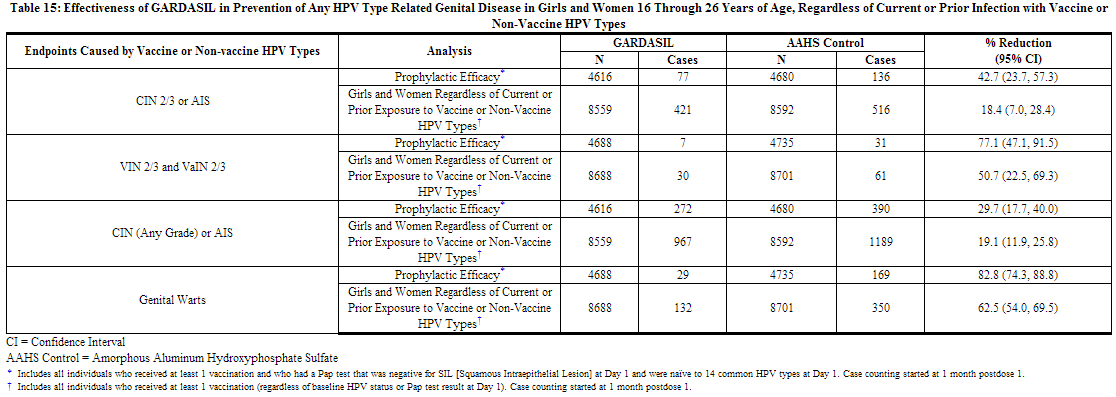
Population Impact in Boys and Men 16 Through 26 Years of Age
Effectiveness of GARDASIL in Prevention of HPV Types 6-, 11-, 16-, or 18-Related Anogenital Disease in Boys and Men 16 Through 26 Years of Age, Regardless of Current or Prior Exposure to Vaccine HPV Types
Study 5 included boys and men regardless of current or prior exposure to vaccine HPV types, and additional analyses were conducted to evaluate the impact of human papillomavirus quadrivalent vaccine with respect to HPV 6-, 11-, 16-, and 18-related anogenital disease in these boys and men. Here, analyses included events arising among boys and men regardless of baseline PCR status and serostatus, including HPV infections that were present at the start of vaccination as well as events that arose from infections that were acquired after the start of vaccination.
The impact of human papillomavirus quadrivalent vaccine in boys and men regardless of current or prior exposure to a vaccine HPV type is shown in Table 16. Impact was measured starting at Day 1. Prophylactic efficacy denotes the vaccine's efficacy in boys and men who are naïve (PCR negative and seronegative) to the relevant HPV types at Day 1. Vaccine impact in boys and men who were positive for vaccine HPV infection, as well as vaccine impact among boys and men regardless of baseline vaccine HPV PCR status and serostatus are also presented. The majority of anogenital disease related to a vaccine HPV type detected in the group that received human papillomavirus quadrivalent vaccine occurred as a consequence of HPV infection with the relevant HPV type that was already present at Day 1.
There was no clear evidence of protection from disease caused by HPV types for which boys and men were PCR positive regardless of serostatus at baseline.
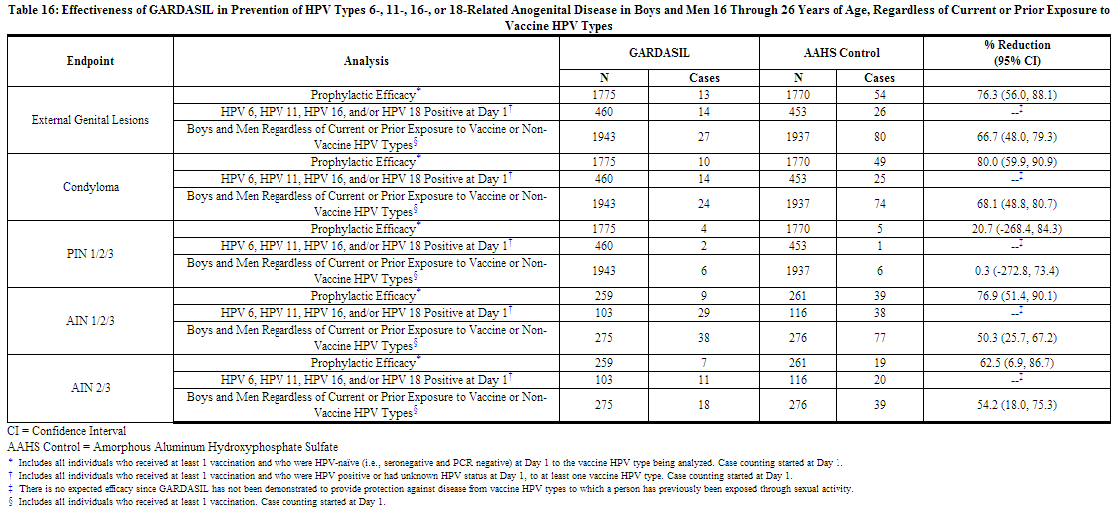
Effectiveness of GARDASIL in Prevention of Any HPV Type Related Anogenital Disease in Boys and Men 16 Through 26 Years of Age, Regardless of Current or Prior Infection with Vaccine or Non-Vaccine HPV Types
The impact of human papillomavirus quadrivalent vaccine against the overall burden of dysplastic or papillomatous anogenital disease regardless of HPV detection, results from a combination of prophylactic efficacy against vaccine HPV types, disease contribution from vaccine HPV types present at time of vaccination, the disease contribution from HPV types not contained in the vaccine, and disease in which HPV was not detected.
Additional efficacy analyses from Study 5 were conducted in 2 populations: (1) a generally HPV-naïve population that consisted of boys and men who are seronegative and PCR negative to HPV 6, 11, 16, and 18 and PCR negative to HPV 31, 33, 35, 39, 45, 51, 52, 56, 58 and 59 at Day 1, approximating a population of sexually-naïve boys and men and (2) the general study population of boys and men regardless of baseline HPV status, some of whom had HPV-related disease at Day 1.
Among generally HPV-naïve boys and men and among all boys and men in Study 5 (including boys and men with HPV infection at Day 1), human papillomavirus quadrivalent vaccine reduced the overall incidence of anogenital disease (Table 17). These reductions were primarily due to reductions in lesions caused by HPV types 6, 11, 16, and 18 in boys and men naïve (seronegative and PCR negative) for the specific relevant vaccine HPV type. Infected boys and men may already have anogenital disease at Day 1 and some will develop anogenital disease during follow-up, either related to a vaccine or non-vaccine HPV type present at the time of vaccination or related to a non-vaccine HPV type not present at the time of vaccination.
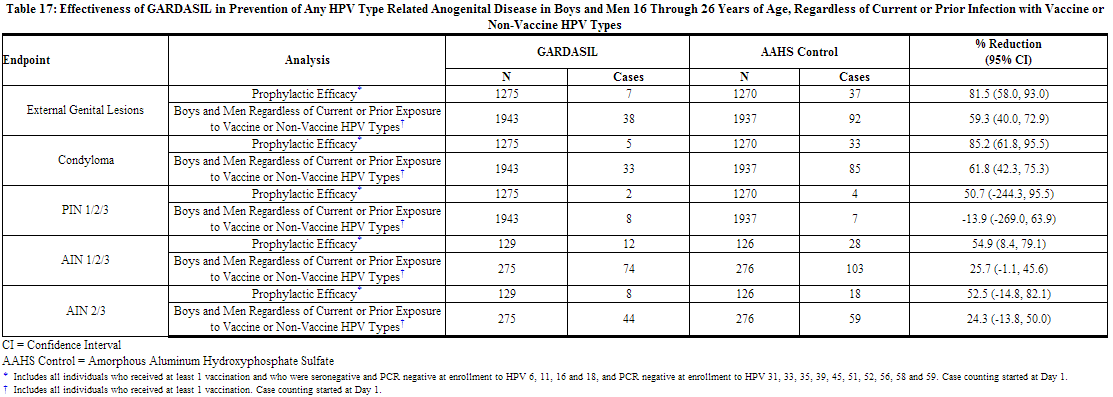
Overall Population Impact
The subject characteristics (e.g. lifetime sex partners, geographic distribution of the subjects) influence the HPV prevalence of the population and therefore the population benefit can vary widely.
The overall efficacy of human papillomavirus quadrivalent vaccine will vary with the baseline prevalence of HPV infection and disease, the incidence of infections against which human papillomavirus quadrivalent vaccine has shown protection, and those infections against which human papillomavirus quadrivalent vaccine has not been shown to protect.
The efficacy of human papillomavirus quadrivalent vaccine for HPV types not included in the vaccine (i.e., cross-protective efficacy) is a component of the overall impact of the vaccine on rates of disease caused by HPV. Cross-protective efficacy was not demonstrated against disease caused by non-vaccine HPV types in the combined database of the Study 3 and Study 4 trials.
human papillomavirus quadrivalent vaccine does not protect against genital disease not related to HPV. One woman who received human papillomavirus quadrivalent vaccine in Study 3 developed an external genital well-differentiated squamous cell carcinoma at Month 24. No HPV DNA was detected in the lesion or in any other samples taken throughout the study.
In 18,150 girls and women enrolled in Study 2, Study 3, and Study 4, human papillomavirus quadrivalent vaccine reduced definitive cervical therapy procedures by 23.9% (95% CI: 15.2%, 31.7%).
Studies in Women 27 Through 45 Years of Age
Study 6 evaluated efficacy in 3253 women 27 through 45 years of age based on a combined endpoint of HPV 6-, 11-, 16- or 18-related persistent infection, genital warts, vulvar and vaginal dysplastic lesions of any grade, CIN of any grade, AIS, and cervical cancer. These women were randomized 1:1 to receive either human papillomavirus quadrivalent vaccine or AAHS control. The efficacy for the combined endpoint was driven primarily by prevention of persistent infection. There was no statistically significant efficacy demonstrated for CIN 2/3, AIS, or cervical cancer. In post hoc analyses conducted to assess the impact of human papillomavirus quadrivalent vaccine on the individual components of the combined endpoint, the results in the population of women naïve to the relevant HPV type at baseline were as follows: prevention of HPV 6-, 11-, 16- or 18-related persistent infection (80.5% [95% CI: 68.3, 88.6]), prevention of HPV 6-, 11-, 16- or 18-related CIN (any grade) (85.8% [95% CI: 52.4, 97.3]), and prevention of HPV 6-, 11-, 16- or 18-related genital warts (87.6% [95% CI: 7.3, 99.7]).
Efficacy for disease endpoints was diminished in a population impact assessment of women who were vaccinated regardless of baseline HPV status (full analysis set). In the full analysis set (FAS), efficacy was not demonstrated for the following endpoints: prevention of HPV 16- and 18-related CIN 2/3, AIS, or cervical cancer and prevention of HPV 6- and 11-related condyloma. No efficacy was demonstrated against CIN 2/3, AIS, or cervical cancer in the general population irrespective of HPV type (FAS any type analysis).
Immunogenicity
Assays to Measure Immune Response
The minimum anti-HPV titer that confers protective efficacy has not been determined.
Because there were few disease cases in individuals naïve (PCR negative and seronegative) to vaccine HPV types at baseline in the group that received human papillomavirus quadrivalent vaccine, it has not been possible to establish minimum anti-HPV 6, anti-HPV 11, anti-HPV 16, and anti-HPV 18 antibody levels that protect against clinical disease caused by HPV 6, 11, 16, and/or 18.
The immunogenicity of human papillomavirus quadrivalent vaccine was assessed in 23,951 9- through 45-year-old girls and women (human papillomavirus quadrivalent vaccine N = 12,634; AAHS control or saline placebo N = 11,317) and 5417 9- through 26-year-old boys and men (human papillomavirus quadrivalent vaccine N = 3109; AAHS control or saline placebo N = 2308).
Type-specific immunoassays with type-specific standards were used to assess immunogenicity to each vaccine HPV type. These assays measured antibodies against neutralizing epitopes for each HPV type. The scales for these assays are unique to each HPV type; thus, comparisons across types and to other assays are not appropriate.
Immune Response to Human Papillomavirus Quadrivalent Vaccine
The primary immunogenicity analyses were conducted in a per-protocol immunogenicity (PPI) population. This population consisted of individuals who were seronegative and PCR negative to the relevant HPV type(s) at enrollment, remained HPV PCR negative to the relevant HPV type(s) through 1 month postdose 3 (Month 7), received all 3 vaccinations, and did not deviate from the study protocol in ways that could interfere with the effects of the vaccine.
Immunogenicity was measured by (1) the percentage of individuals who were seropositive for antibodies against the relevant vaccine HPV type, and (2) the Geometric Mean Titer (GMT).
In clinical studies in 16- through 26-year-old girls and women, 99.8%, 99.8%, 99.8%, and 99.4% who received human papillomavirus quadrivalent vaccine became anti-HPV 6, anti-HPV 11, anti-HPV 16, and anti-HPV 18 seropositive, respectively, by 1 month postdose 3 across all age groups tested.
In clinical studies in 27- through 45-year-old women, 98.2%, 97.9%, 98.6%, and 97.1% who received human papillomavirus quadrivalent vaccine became anti-HPV 6, anti-HPV 11, anti-HPV 16, and anti-HPV 18 seropositive, respectively, by 1 month postdose 3 across all age groups tested.
In clinical studies in 16- through 26-year-old boys and men, 98.9%, 99.2%, 98.8%, and 97.4% who received GARDASIL became anti-HPV 6, anti-HPV 11, anti-HPV 16, and anti-HPV 18 seropositive, respectively, by 1 month postdose 3 across all age groups tested.
Across all populations, anti-HPV 6, anti-HPV 11, anti-HPV 16, and anti-HPV 18 GMTs peaked at Month 7 (Table 18 and Table 19). GMTs declined through Month 24 and then stabilized through Month 36 at levels above baseline. Tables 20 and 21 display the persistence of anti-HPV cLIA geometric mean titers by gender and age group. The duration of immunity following a complete schedule of immunization with human papillomavirus quadrivalent vaccine has not been established.
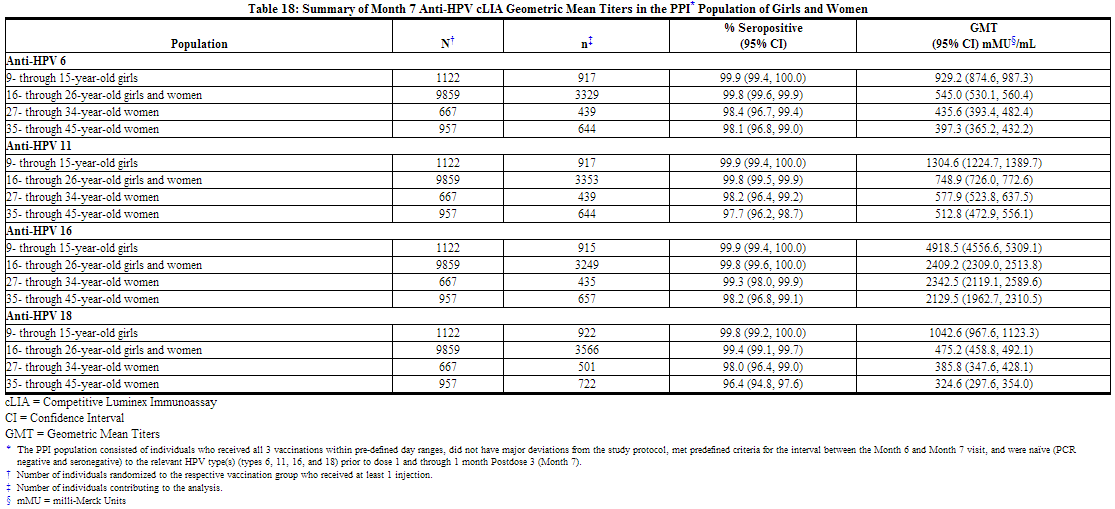
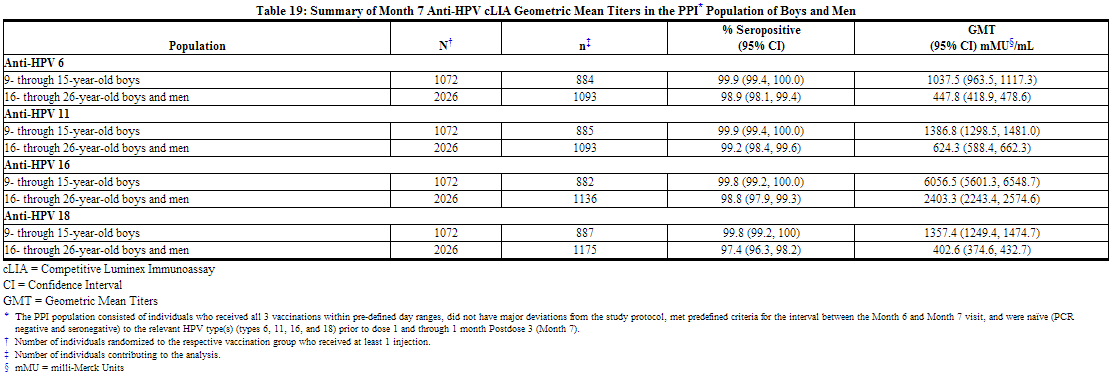
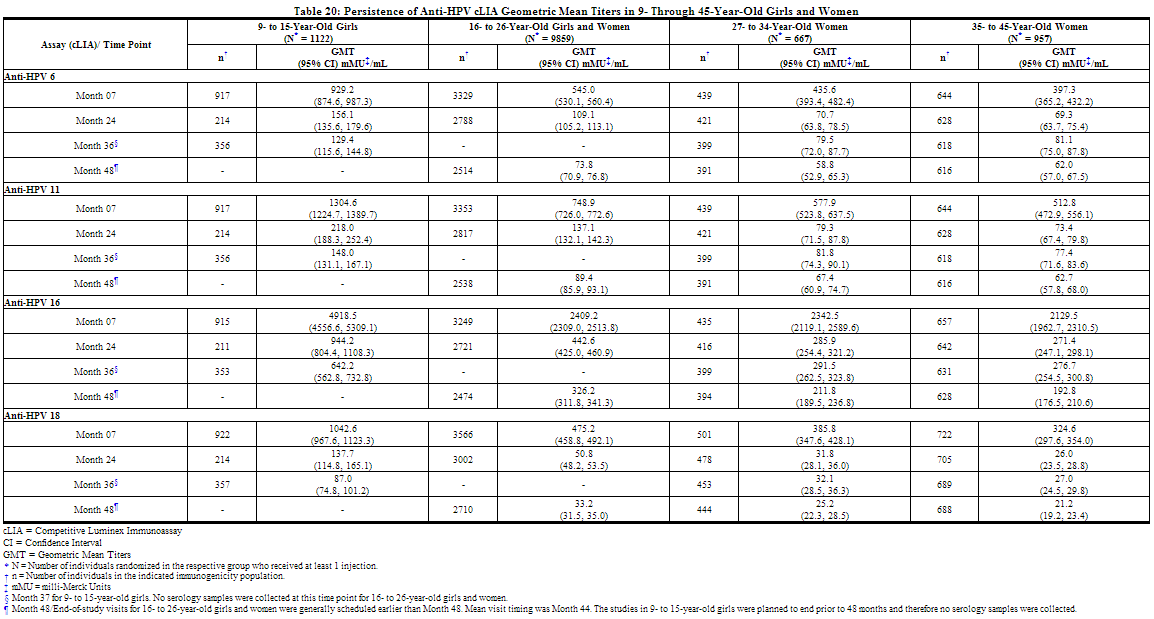
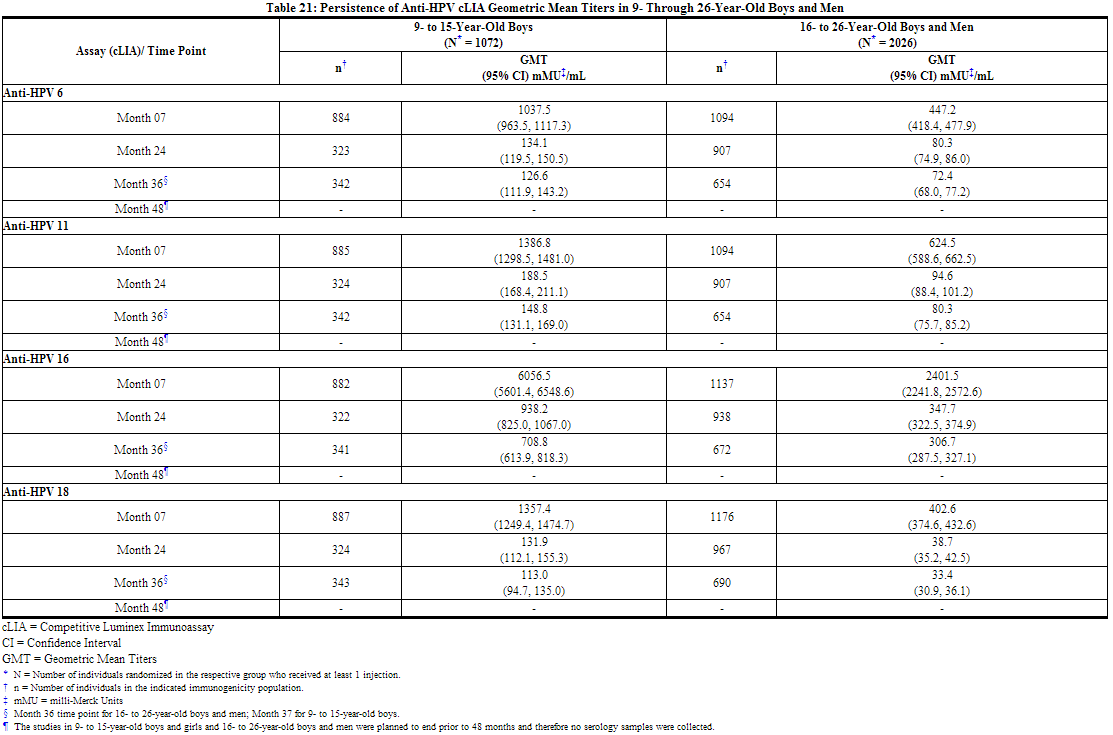
Tables 18 and 19 display the Month 7 immunogenicity data for girls and women and boys and men. Anti-HPV responses 1 month postdose 3 among 9- through 15-year-old adolescent girls were non-inferior to anti-HPV responses in 16- through 26-year-old girls and women in the combined database of immunogenicity studies for human papillomavirus quadrivalent vaccine. Anti-HPV responses 1 month postdose 3 among 9- through 15-year-old adolescent boys were non-inferior to anti-HPV responses in 16- through 26-year-old boys and men in Study 5.
On the basis of this immunogenicity bridging, the efficacy of human papillomavirus quadrivalent vaccine in 9- through 15-year-old adolescent girls and boys is inferred.
GMT Response to Variation in Dosing Regimen in 18- Through 26-Year-Old Women
Girls and women evaluated in the PPE population of clinical studies received all 3 vaccinations within 1 year of enrollment. An analysis of immune response data suggests that flexibility of ±1 month for Dose 2 (i.e., Month 1 to Month 3 in the vaccination regimen) and flexibility of ±2 months for Dose 3 (i.e., Month 4 to Month 8 in the vaccination regimen) do not impact the immune responses to human papillomavirus quadrivalent vaccine.
Duration of the Immune Response to GARDASIL
The duration of immunity following a complete schedule of immunization with human papillomavirus quadrivalent vaccine has not been established. The peak anti-HPV GMTs for HPV types 6, 11, 16, and 18 occurred at Month 7. Anti-HPV GMTs for HPV types 6, 11, 16, and 18 were similar between measurements at Month 24 and Month 60 in Study 2.
Studies with Hepatitis B Vaccine (recombinant)]
The safety and immunogenicity of co-administration of human papillomavirus quadrivalent vaccine with hepatitis B vaccine (recombinant) (same visit, injections at separate sites) were evaluated in a randomized, double-blind, study of 1871 women aged 16 through 24 years at enrollment. The race distribution of the girls and women in the clinical trial was as follows: 61.6% White; 1.6% Hispanic (Black and White); 23.8% Other; 11.9% Black; 0.8% Asian; and 0.3% American Indian.
Subjects either received human papillomavirus quadrivalent vaccine and hepatitis B vaccine (recombinant) (n = 466), human papillomavirus quadrivalent vaccine and hepatitis B vaccine (recombinant)-matched placebo (n = 468), hepatitis B vaccine (recombinant) and human papillomavirus quadrivalent vaccine-matched placebo (n = 467) or hepatitis B vaccine (recombinant)-matched placebo and human papillomavirus quadrivalent vaccine-matched placebo (n = 470) at Day 1, Month 2 and Month 6. Immunogenicity was assessed for all vaccines 1 month post completion of the vaccination series.
Concomitant administration of human papillomavirus quadrivalent vaccine with hepatitis B vaccine (recombinant) did not interfere with the antibody response to any of the vaccine antigens when human papillomavirus quadrivalent vaccine was given concomitantly with hepatitis B vaccine (recombinant) or separately.
Studies with Menactra [Meningococcal (Groups A, C, Y and W-135) Polysaccharide Diphtheria Toxoid Conjugate Vaccine] and Adacel [Tetanus Toxoid, Reduced Diphtheria Toxoid and Acellular Pertussis Vaccine Adsorbed (Tdap)]
The safety and immunogenicity of co-administration of human papillomavirus quadrivalent vaccine with Menactra (Meningococcal (Groups A, C, Y and W-135) Polysaccharide Diphtheria Toxoid Conjugate Vaccine) and Adacel [Tetanus Toxoid, Reduced Diphtheria Toxoid and Acellular Pertussis Vaccine Adsorbed (Tdap)] (same visit, injections at separate sites) were evaluated in an open-labeled, randomized, controlled study of 1040 boys and girls 11 through 17 years of age at enrollment. The race distribution of the subjects in the clinical trial was as follows: 77.7% White; 6.8% Hispanic (Black and White); 1.4% Multi-racial; 12.3% Black; 1.2% Asian; 0.2% Indian; and 0.4% American Indian.
One group received human papillomavirus quadrivalent vaccine in one limb and both Menactra and Adacel, as separate injections, in the opposite limb concomitantly on Day 1 (n = 517). The second group received the first dose of human papillomavirus quadrivalent vaccine on Day 1 in one limb then Menactra and Adacel, as separate injections, at Month 1 in the opposite limb (n = 523). Subjects in both vaccination groups received the second dose of human papillomavirus quadrivalent vaccine at Month 2 and the third dose at Month 6. Immunogenicity was assessed for all vaccines 1 month post completion of the vaccination series (1 dose for Menactra and Adacel and 3 doses for human papillomavirus quadrivalent vaccine).
Concomitant administration of human papillomavirus quadrivalent vaccine with Menactra (Meningococcal (Groups A, C, Y and W-135) Polysaccharide Diphtheria Toxoid Conjugate Vaccine) and Adacel [Tetanus Toxoid, Reduced Diphtheria Toxoid and Acellular Pertussis Vaccine Adsorbed (Tdap)] did not interfere with the antibody response to any of the vaccine antigens when human papillomavirus quadrivalent vaccine was given concomitantly with Menactra and Adacel or separately.
How Supplied
All presentations for GARDASIL contain a suspension of 120 mcg L1 protein from HPV types 6, 11, 16, and 18 in a 0.5-mL dose. GARDASIL is supplied in vials and syringes.
- Carton of one 0.5-mL single-dose vial. NDC 0006-4045-00.
- Carton of ten 0.5-mL single-dose vials. NDC 0006-4045-41.
- Carton of six 0.5-mL single-dose prefilled Luer-Lok® syringes with tip caps. NDC 0006-4109-09.
- Carton of ten 0.5-mL single-dose prefilled Luer-Lok® syringes with tip caps. NDC 0006-4109-02.
Storage
- Store refrigerated at 2 to 8°C (36 to 46°F). Do not freeze. Protect from light.
- GARDASIL should be administered as soon as possible after being removed from refrigeration.
- GARDASIL can be out of refrigeration (at temperatures at or below 25°C/77°F), for a total time of not more than 72 hours.
Images
Drug Images
{{#ask: Page Name::HPV Vaccine |?Pill Name |?Drug Name |?Pill Ingred |?Pill Imprint |?Pill Dosage |?Pill Color |?Pill Shape |?Pill Size (mm) |?Pill Scoring |?NDC |?Drug Author |format=template |template=DrugPageImages |mainlabel=- |sort=Pill Name }}
Package and Label Display Panel
{{#ask: Label Page::HPV Vaccine |?Label Name |format=template |template=DrugLabelImages |mainlabel=- |sort=Label Page }}
Patient Counseling Information
Advise the patient to read the FDA-approved patient labeling (Patient Information). Inform the patient, parent, or guardian:
- Vaccination does not eliminate the necessity for women to continue to undergo recommended cervical cancer screening. Women who receive human papillomavirus quadrivalent vaccine should continue to undergo cervical cancer screening per standard of care.
- Recipients of human papillomavirus quadrivalent vaccine should not discontinue anal cancer screening if it has been recommended by a health care provider.
- Human papillomavirus quadrivalent vaccine has not been demonstrated to provide protection against disease from vaccine and non-vaccine HPV types to which a person has previously been exposed through sexual activity.
- Since syncope has been reported following vaccination sometimes resulting in falling with injury, observation for 15 minutes after administration is recommended.
- Vaccine information is required to be given with each vaccination to the patient, parent, or guardian.
- Information regarding benefits and risks associated with vaccination.
- Human papillomavirus quadrivalent vaccine is not recommended for use in pregnant women.
- Importance of completing the immunization series unless contraindicated.
- Report any adverse reactions to their health care provider.
Precautions with Alcohol
Alcohol-HPV Vaccine interaction has not been established. Talk to your doctor about the effects of taking alcohol with this medication.
Brand Names
Gardasil
Look-Alike Drug Names
There is limited information regarding HPV Vaccine Look-Alike Drug Names in the drug label.
Drug Shortage Status
Drug Shortage
Price
References
The contents of this FDA label are provided by the National Library of Medicine.
- ↑ 1.0 1.1 Brown DR, Kjaer SK, Sigurdsson K, Iversen OE, Hernandez-Avila M, Wheeler CM; et al. (2009). "The impact of quadrivalent human papillomavirus (HPV; types 6, 11, 16, and 18) L1 virus-like particle vaccine on infection and disease due to oncogenic nonvaccine HPV types in generally HPV-naive women aged 16-26 years". J Infect Dis. 199 (7): 926–35. doi:10.1086/597307. PMID 19236279.
- ↑ 2.0 2.1 Wheeler CM, Kjaer SK, Sigurdsson K, Iversen OE, Hernandez-Avila M, Perez G; et al. (2009). "The impact of quadrivalent human papillomavirus (HPV; types 6, 11, 16, and 18) L1 virus-like particle vaccine on infection and disease due to oncogenic nonvaccine HPV types in sexually active women aged 16-26 years". J Infect Dis. 199 (7): 936–44. doi:10.1086/597309. PMID 19236277.
{{#subobject:
|Label Page=HPV Vaccine |Label Name=Human Papilomavirus Vaccine Package.png
}}